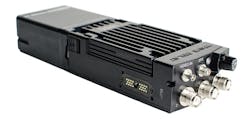Download this article as a .PDF
Robots are playing larger roles in military efforts, and even robots need reliable radios to communicate. What better way for them to connect with each other and with humans than by using a “smart” radio, such as the MPU5 smart radio from Persistent Systems? This mobile ad hoc networking (MANET) radio will provide communications links for ground robots being supplied to the U.S. Army MTRS Inc II program by Endeavor Robotics. A total of 2,400 MPU5 smart radios are being supplied for 1,200 robots as part of a $100 million IDIQ contract.
With the compact MPU5 smart radios (Fig. 1) installed on the MTRS Inc II ground robots, they are connected to each other and to their human operators, who will have wireless control of the unmanned ground vehicles (UGVs). This contract expands the number of participants in Persistent Systems’ networked ecosystem, which includes unmanned aerial vehicles (UAVs), UGVs, fixed sensors, and even legacy radios. This news comes on the heels of Persistent’s September $8.9 million contract win to support Army National Guard counter-WMD civil support teams by networking their chemical, biological, radiological, nuclear, or explosive (CBRNE) sensors.
1. The MPU5 smart radios are highly computerized tactical radios with interchangeable frequency modules for L-, S-, and C-band frequencies that are being installed in the Endeavor Robotics ground robots being supplied to the U.S. Army MTRS Inc II program. (Photo courtesy of Persistent Systems, LLC)
The MPU5 is based on software-defined-radio (SDR) technology and the company’s own Wave Relay transmission algorithms. It is computer-intensive, with 1-GHz quad-core ARM, 2 GB RAM, and 128 GB of flash memory storage for flexibility when adapting to changing network communications conditions in the field. The phone can run Android Tactical Assault Kit (ATAK) software and other programs. In spite of the computing power, the radio is small enough to fit in the palm of the hand and won’t slow down the robotic UGVs on which they are installed.
These small tactical radios are modular in terms of frequency, and can operate over three frequency bands: L-band, S-band, or C-band. As much as 6 W transmit power is available for any of the three frequency bands, which can be exchanged in the field for networking flexibility. The MPU5 is a true MANET solution with Cloud computing capability; it supports 3×3 multiple-input, multiple-output (MIMO) communications with data throughput of better than 100 Mb/s. It has a built-in GPS receiver which is updated every 1 s for navigational and locational precision.
The three interchangeable frequency modules are the RF-1100, which covers the L-band frequency range of 1,350 to 1,390 MHz; the RF-2100 module, which operates at S-band frequencies of 2,200 to 2,500 MHz; and the RF-4100 module, which operates over the lower C-band frequency range of 4,435 to 4,980 MHz. The radios and their modules feature software configurable bandwidths of 5, 10, and 20 MHz.
2. The MPU5 smart radios will provide the means for men and machines to communicate securely in the field, as part of a new U.S. Army IDIQ contract. (Photo courtesy of Persistent Systems, LLC)
The Army’s UGVs will have full wireless and wired connectivity options, since the radios include USB host and RS-232 serial ports, Ethernet, and USB-on-the-Go connections. The MPU5 smart radios also include multiple power-charging options, with an end-user-device (EUD) data/charging port, a charging downstream port (CDP) port rated for 1500 mA, and a standard charging port (SDP) rated for 500 mA. The radios require 8 to 28 V dc for operation. They are MIL-STD certified and designed for use by both men and machines (Fig. 2) over an operating temperature range of −40 to +85ºC.
Persistent Systems, LLC, 303 Fifth Ave., Ste. 306, New York, NY 10016; (212) 561-5895



